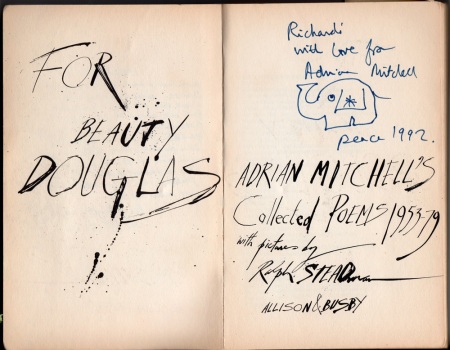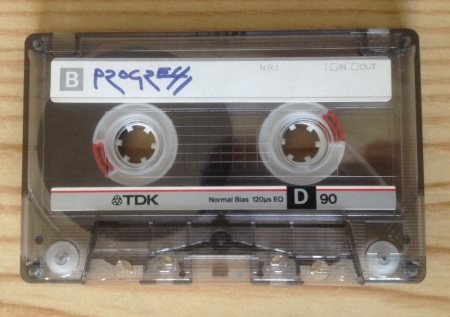1. Write a blog post about him. Here it is.
I suspect like many people, I became aware of poet Adrian Mitchell’s work when I randomly heard a recording of Peter O’ Toole reading “To Whom It May Concern” (otherwise popularly known as “Tell me lies about Vietnam”) at some anti-war rally in Britain many years ago. Googling it I can’t find any references and wonder sometimes if I just imagined it, but it doesn’t matter, hearing that poem is what led me to discover Adrian Mitchell.
2. Tell a story about meeting him.
I met Adrian Mitchell once in 1992 when he was touring the country to promote his “Greatest Hits” book. I lived in Rotherham at the time and he and musician Pete Moser came to perform at the local Arts Centre. Because he was quite famous I made sure I got my tickets months in advance, expecting it to sell out. There were just five of us in the audience.
After the show he sold and signed copies of his new book and I took my copy of “For Beauty Douglas” to have it signed (see above). I apologized on behalf the people of Rotherham for the meager turnout. He was very gracious and friendly, and quite philosophical about the turnout, and I’m glad that I liked him in real life.
3. Quote him.
“Most people ignore most poetry because most poetry ignores most people.”
4. Parody his work in a way you hope he would like.
Ten ways to avoid selling fish and chips to any artist
Tracey Emin walks into a chip shop and says “I’d like fish and chips, please”.
The owner says “Not everything is about you”.
Damien Hirst walks into a chip shop and says “What fish have you got?”.
The owner says “Shark’s off”.
Pablo Picasso walks into a chip shop and says “Fish and chips, please”.
The owner says “The wife’s busy”.
Renee Magritte walks into a chip shop and says “Fish and chips, please”.
The owner says “This is not a chip shop”.
David Mamet walks into a chip shop and says “Fish and chips, please”.
The owner says “Fish and chips, please?”.
David Mamet says “That’s what I’m asking”.
The owner says “That’s what you’re asking?”.
Ridley Scott walks into a chip shop and says “Fish and chips, please”.
The owner says “Stop shining that light in my eyes”.
Robert De Niro walks into a chip shop and says “Fish and chips, please”.
The owner says “Are you looking at my fish?”.
Laurie Anderson walks into a chip shop and says “This must be the plaice”.
The owner says “Outside.”
Richard Bolam walks into a chip shop and says “Fish and chips, please”.
The owner says “Who the fuck are you?”.
Adrian Mitchell walks into a chip shop and says “Fish and chips, please”.
The owner says “There’s no fish and no chips, but we do have mushy peace”.
5. Spread his message of peace.
Adrian Mitchell was a committed pacifist and social activist. All he wanted was for people to stop killing each other.
6. Repeat an anecdote about him.
Adrian Mitchell included instructions in several of his books that it was forbidden to use any of his work in connection with any examination. An exam board once used one of his poems, without permission, in their ‘O’ Level and CSE level papers. The Guardian newspaper arranged for him to take the same exam and had it independently marked. For the questions about his own work he scored 14 out of a possible 40 marks.
7. Introduce someone else to his work. That’s one of you lot.
8. Reproduce one of his poems without permission. He would approve.
I like that stuff
Lovers lie around in it
Broken glass is found in it
Grass
I like that stuff
Tuna fish get trapped in it
Legs come wrapped in it
Nylon
I like that stuff
Eskimos and tramps chew it
Madame Tussaud gave status to it
Wax
I like that stuff
Elephants get sprayed with it
Scotch is made with it
Water
I like that stuff
Clergy are dumbfounded by it
Bones are surrounded by it
Flesh
I like that stuff
Harps are strung with it
Mattresses are sprung with it
Wire
I like that stuff
Carpenters make cots of it
Undertakers use lots of it
Wood
I like that stuff
Cigarettes are lit by it
Pensioners are happy when they sit by it
Fire
I like that stuff
Dankworth’s alto is made of it, most of it,
Scoobeedo is composed of it
Plastic
I like that stuff
Apemen take it to make them hairier
I ate a ton of it in Bulgaria
Yoghurt
I like that stuff
Man-made fibres and raw materials
Old rolled gold and breakfast cereals
Platinum linoleum
I like that stuff
Skin on my hands
Hair on my head
Toenails on my feet
And linen on my bed
Well I like that stuff
Yes I like that stuff
The earth
Is made of earth
And I like that stuff
9. Write your own poem. He’d like that.
I could die here (extract)
A cough
And then another cough
Then another
And another
And another
In a loop of breath
That has no breath in it
I spoke to a friend without speaking
She said “Don’t die”
And so I didn’t
Even so I remember:
I could die here
10. Publish it. Here it is.
http://www.adrianmitchell.co.uk/
http://petemoser.com/
http://www.bloodaxebooks.com/







